- Submissions

Full Text
Research & Development in Material Science
Mechanical Behavior of Ni-Ti SMA Helical Springs Manufactured by Investment Casting
Jackson de Brito Simões1, José Joelson de Melo Santiago2, Paulo César Sales da Silva2 and Carlos José de Araújo2*
1Federal Rural University of the Semi-Arid (UFERSA), Brazil
2Federal University of Campina Grande (UFCG), Brazil
*Corresponding author: Carlos José de Araújo, Multidisciplinary Lab of Active Materials and Structures (LaMMEA), Federal University of Campina Grande (UFCG), Av. Aprígio Veloso, 882, Campina Grande, PB, 58429-140, Brazil
Submission: March 03, 2018;Published: April 02, 2018

ISSN: 2576-8840
Volume5 Issue2
Abstract
Shape Memory Alloys (SMA) are smart metallic materials that have being increasingly studied due to their functional properties of recovering original shape by heating after pseudo plastic deformation and super elasticity. In this context, SMA helical springs can be used as actuators or sensors in several areas. This work aims to perform thermal and mechanical characterization of Ni-Ti SMA helical springs produced by investment casting process consisting of induction melting followed by centrifugal casting (ICC). Thermal characterization of the springs was performed by Electrical Resistance as a function of Temperature (ERT), while the mechanical characterizations in static and dynamic regimes were performed in an Instron Model E10000 machine. Results of thermal analysis by ERT showed that the helical Ni-Ti springs have phase transformation corresponding to the super elastic effect (SE) at room temperature (~23.5±0.5 °C). Reversible deformations under uniaxial tensile were of the order of 80% and dynamic tests showed that mechanical behavior vary according to the frequency and deformation amplitude. At last, it was verified that Ni-Ti SMA helical springs produced by ICC process present functional characteristics, which are suitable for super elastic applications such as springs manufactured by conventional processes.
Keywords: Helical springs; Shape memory alloys; Ni-Ti alloys; Investment casting
Introduction
Engineers have been seeking to improve product efficiency increasing efficiency/weight ratio of systems without compromising costs. Thus, the substitution of systems composed of several components by a simple multifunctional device, using active materials, can be an advantageous and interesting alternative [1]. In the last decades, researchers have constantly sought to develop applications with high performance materials, which provide minimized drive components, weight reduction, silent performance and smart intrinsic functions. Shape memory alloys (SMA) is among these materials, mainly Ni-Ti alloys, due to its more expressive thermo mechanical properties compared to others SMA, which can present Shape Memory Effect (SME) or Super elastic Effect (SE) [2]. Super elasticity was described by [3] as an ability of SMA to recover large deformations (~8%) after removing mechanical load that caused deformation. This occurs due to the austenite to martensite (solid-solid) stress induced phase transformation in the material. Although commercial applications of Ni-Ti SMA have occurred, they have not grown significantly, except in the biomedical field, mainly due to manufacturing difficulties and high costs involved to make projects viable [1]. Among the several products possible to be manufactured from Ni-Ti SMA, helical springs are considered interesting designs, allowing applications in thermomechanical valves [2] and also for vibration attenuation in a passive or active way, as demonstrated recently by [4,5]. In general, these smart coil springs are manufactured from commercially available Ni- Ti SMA wires by means of a thermomechanical forming process known as “shape setting” [1,6]. However, this process depends on the preliminary fabrication of the Ni-Ti SMA wires, which is a difficult task. In addition, for customized applications involving larger diameter wire springs (greater than 1mm), it may be more interesting to obtain the helical spring shape directly from a metallurgical conformation. In this context, this paper aimed to analyze the mechanical behavior of Ni-Ti SMA helical springs manufactured by a novel process, corresponding to investment casting with lost wax technique and centrifugal molten injection into ceramic molds. This manufacturing process can be considered an innovative method for SMA products, including helical coil springs.
Material and Methods
Manufacturing process
Helical springs were manufactured using the methodology developed by [7] for Ni-Ti SMA mechanical components. The SMA used to obtain helical springs was 55.3Ni-44,7Ti (%wt). This composition was selected in order to observe a complete or partial super elastic behavior at room temperature (~25±2 °C). Manufacturing of Ni-Ti SMA ingots (20 to 30 grams) was carried out using the Plasma Skull Push Pull (PSPP) process. This method was validated to manufacture SMA by [8]. To manufacture the helical springs from the Ni-Ti SMA ingots, a wax model with design and dimensions of final product was used to make ceramic molds. Then, ceramic coating indicated for titanium alloys in dental applications (Microfine 1700) and was used to obtain solid molds. The production stages of the Ni-Ti SMA spring are shown in Figure 1. Ceramic molds were cured in an electric heat furnace using a thermal cycle consisting of a heating ramp from room temperature to 750 °C at a rate of 20 °C/min, remaining at that final temperature for 20 minutes in order to solidify the ceramic coating and remove the wax completely.
Figure 1: Steps to obtain the Ni-Ti SMA helical springs, (A) Wax models, (B) Model tree, (C) Ceramic mold after casting, (D) Cleaning, (E) Cast tree, (F) Ni-Ti final helical spring.

For the final casting of Ni-Ti SMA ingots obtained previously by PSPP, the Power Cast 1700 equipment (EDG, Brazil) was used. The Ni-Ti ingot was placed in a ceramic crucible, subjected to a flow of argon gas and melted by induction. The injection of the Ni-Ti molten into the ceramic coating mold was performed by centrifugation. After this whole process, the ceramic coating was completely removed by blasting powdered alumina. Further, as cast Ni-Ti SMA helical springs were heat treated at 850 °C for 1 hour followed by aging at 500 °C for 2 hours.
Thermal characterization
Phase transformation temperatures of the Ni-Ti SMA helical springs shown in Figure 1(F) were determined by means of Electrical Resistance as a function of Temperature (ERT). This is a non-destructive technique in which the Ni-Ti SMA spring is placed into a thermal controlled silicone oil bath and submitted to a constant electrical current of low intensity to cause a potential difference between two points. Subsequently, the coil spring is subjected to cooling and heating in a temperature range of -60 °C to 120 °C, at a rate of about 3 °C/min. The voltage drop and temperature are captured by a data acquisition system (Agilent, 34970A) and storage in a desktop computer for further treatment. Application of tangent lines on the ERT curves allows determining the phase transformation temperatures. The advantage of this technique, compared to other thermal analysis (DSC or DTA), is that it allows to determine the transformation temperatures of the entire mechanical component, and not only using a small part extracted from it.
Mechanical characterization
Mechanical tests were carried out at room temperature (~23.5±0.5 °C) using an Electropuls E10000 test machine (Instron) equipped with a 10kN load cell. Ni-Ti SMA springs were initially subjected to mechanical cycling of 60% deformation to stabilize the superelastic behavior. Then, quasi static tensile tests with 4 cycles of loading/unloading at varied deformations of 20%, 40%, 60% and 80% were taken reliving the applied force to a residual force during the unloading stage in each cycle. A strain rate of 1%/min was used during the loading and unloading stages. Subsequently, tests of dynamic mechanical extension/compression were performed, in which Ni-Ti SMA springs were subjected to loading and unloading cycles varying the excitation frequency at 1Hz, 2.5Hz and 5Hz, with deformation amplitude of 80% (±40%). The 40% deformation in compression corresponds to the limit to prevent the coils from touching, since the springs are originally open. Figure 2 show the assembly for mechanical characterization of the Ni-Ti SMA springs with 4 active coils and the springs design with a spring index of 6. During the tests a 100m diameter K type micro thermocouple was installed in the center of the length of the Ni-Ti spring to monitor the temperature behavior during cycling.
Figure 2: Mechanical tests of the Ni-Ti SMA springs. (A) Electro Pulse E10000 Dynamic Machine. (B) Experimental Assembly for test. (C) Mechanical design and dimensions in mm of the Ni-Ti SMA helical springs: height (H) - 40, inner diameter (Di) - 7.5, outer diameter (De) -10.5, wire diameter (d) -1.5.
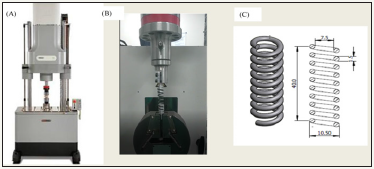
Results and Discussion
Thermal characterization of Ni-Ti springs
Figure 3 show the aspect of the ERT curve for the Ni-Ti SMA springs obtained by investment casting. The ERT behavior was typical of Ni-Ti SMA presenting a two-step phase transformation during cooling, from austenite to R-phase and then to martensite [9]. This transformation behavior is characterized by an ERT peak during cooling. The phase transformation temperatures obtained by ERT for the Ni-Ti SMA springs were: Martensite Finish Temperature (Mf)=-24.6 °C; Martensite Start Temperature (Ms)=8.1 °C; R-Phase Finish Temperature (Rf)=21.0 °C; R-Phase Start Temperature (Rs)=29.0 °C; Austenite Start Temperature (As)=25.8 °C; Austenite Finish Temperature (Af)=38.4 °C. From the analysis of the ERT curve, it can be observed that the Ni-Ti SMA springs will present complete or partial superelasticity because room temperature (~25±2 °C) is located between Rs and Af. Therefore, in order to confirm this SE behavior, before the mechanical tests SMA springs were heated to a temperature higher than Af (up to 60 °C) and then cooled down at room temperature, which is near than the Rs temperature.
Figure 3: ERT behavior of Ni-Ti SMA helical springs.
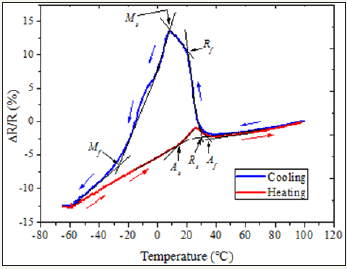
Mechanical characterization of Ni-Ti springs
Figure 4: Static mechanical cyclic behavior of the Ni-Ti springs.
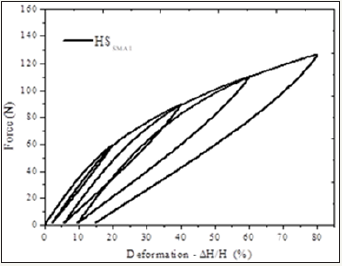
Results of mechanical axial quasi-static tensile tests are shown in Figure 4 while dynamic extension/compression tests are shown in Figure 5-7 for different frequencies, highlighting the first (1st) and last cycle (128th). For static tensile tests (Figure 4), it was verified that Ni-Ti springs reached a force of 120N, when subjected to deformation of 80%. It can be observed that the super elastic deformation was of the order of 65%, due to a residual deformation of 15% after unloading in the last cycle. For dynamic tests, for all frequencies, it was verified an asymmetry between extension and compression, in order to require more force to reach the 40% deformation in compression than in extension. This asymmetry decreases as the frequency increases to 5Hz. Qualitatively, it can be observed that stiffness increases slightly when the frequency increase from 1Hz to 5Hz for a constant deformation amplitude of 80% (-40% to +40%). This behavior of increasing the load to reach the same final deformation during cycling up to ±40% can be attributed to the phenomenon of self-heating of the Ni-Ti SMA spring. This is due to the fact that the phase transformation is endothermic during loading and exothermic in the unloading, generating an accumulation of latent heat that is not fully dissipated by natural convection. This accumulation of heat along the cycles causes a rise in temperature of the spring leading, by Clausius Clayperon’s law for SMA, to increased loading to achieve the same final deformation. This behavior of self-heating was shown experimentally by [10] during strain controlled cyclic tensile tests of Ni-Ti SMA wires of 0.5mm diameter cycled in super elasticity between 0.5Hz and 25Hz.
Figure 5: Dynamic mechanical behavior at a frequency of 1Hz and amplitude of 80%.
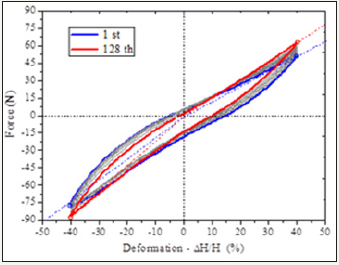
Figure 8 shows that this self-heating phenomenon also occurs in the Ni-Ti springs during cycling. It has been found that higher is the loading frequency, higher is the temperature rise of the spring, which reaches more than 30 °C to 5Hz, corresponding to an increase of 6.7 °C from the room temperature (23.5 °C). By converting the deformations of Figure 5-7 for displacement in meters and integrating force vs. displacement loops it is possible to obtain the energy dissipated [11] by the Ni-Ti springs in the first and last complete cycles of extension and compression. Figure 9 shows the behavior of the dissipated energy as a function of the loading frequency, for two complete cycles (cycles 2 and 128). There is a reduction of energy dissipated during the transient period (from cycle 1 to 128) for all frequencies. After stabilization, corresponding to cycle 128, it is verified that the dissipated energy tends to present a linear increase with the frequency. This is due to the fact that hysteresis loops become more symmetrical with increasing frequency. In general, for superelastic Ni-Ti wires under tensile loading the dissipated energy tends to decrease with increasing frequency [10]. However, this is a complex behavior that needs to be better investigated especially in Ni-Ti springs because it is associated with the existence or not of an important self-heating of the material due to phase transformation in the presence of shear stresses.
Figure 6: Dynamic mechanical behavior at a frequency of 2.5Hz and amplitude of 80%.
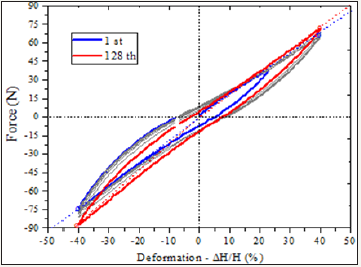
Figure 7: Dynamic mechanical behavior at a frequency of 5Hz and amplitude of 80%.
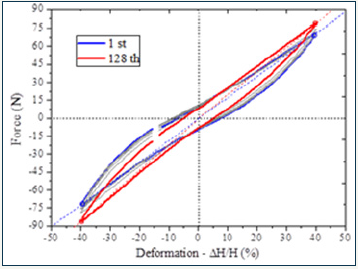
Figure 8: Temperature behavior of the Ni-Ti SMA spring during cycling.

Conclusion
In this study, mechanical characterization of Ni-Ti shape memory alloy springs obtained by investment casting as an alternative to shape setting was performed for the first time. The Ni-Ti SMA helical springs manufactured by investment casting present phase transformation temperatures between -30 °C and +40 °C. During mechanical tests, springs supported static deformations up to 80% of extension with no rupture. It was verified that the maximum force to produce controlled extension and compression between ±40% in dynamic tests is dependent of the loading frequency, increasing with frequency in the range of 1Hz to 5Hz. This behavior was attributed to a self-heating of the Ni-Ti spring during cycling, due to an accumulation of heat generated by the successive cycles of phase transformation. This behavior causes dissipated energy to increase with frequency when the Ni-Ti spring is in a permanent cycling regime (cycle 128).
Acknowledgement
The authors thank the National Council for Scientific and Technological Development (CNPq) Brazilian office for sponsoring the National Institute of Science and Technology for Smart Structures in Engineering (INCT-EIE, grant number 574001/2008- 5), Universal 01/2016 (grant number 401128/2016-4) and PQ-1D (grant number 304658/2014-6). We are also grateful to UFERSA for the Project PEG0001-2017 and technical cooperation agreement number 07/2017 UFERSA-UFCG.
References
- Rao A, Srinivasa R, Reddy JN (2015) Design of shape memory alloy (SMA) actuators. Springer International Publishing, New York, USA.
- Czechowicz SL (2015) Shape memory alloy valves. (1st edn), Springer International Publishing, Texas, USA.
- Doraiswamy S, Rao A, Srinivasa AR (2011) Combining thermodynamic principles with preisach models for superelastic shape memory alloy wires. Smart Materials and Structures 20: 85032.
- Holanda SA, Silva AA, Araújo CJD, Aquino AS (2014) Study of the complex stiffness of a vibratory mechanical system with shape memory alloy coil spring actuator. Shock and Vibration Volume 11.
- Enemark S, Santos IF (2016) Rotor-bearing system integrated with shape memory alloy springs for ensuring adaptable dynamics and damping enhancement-Theory and experiment. Journal of Sound and Vibration 369: 29-49.
- Heidaril B, Kadkhodaei M, Barati M, Karimzadeh F (2016) Fabrication and modeling of shape memory alloy springs. Smart Materials and Structures 25(12): 1-16.
- Simões JB (2016) Fabricação de componentes miniaturizados de ligas com memória de forma Ni-Ti usando fundição de precisão. Federal University of Campina Grande, Campina Grande-PB, Brazil, p. 241.
- De Araújo CJ, Gomes AAC, Silva JA, Cavalcanti AJT, Reis RPB, et al. (2009) Fabrication of shape memory alloy using the plasma skull push-pull process. Journal of materials processing technology 209(7): 3657-3664.
- Otsuka K, Wayman CM (1998) Shape memory materials. (1st edn), Cambridge University Press, Cambridge, UK.
- Oliveira HMR, Grassi END, De Araújo CJ (2012) Dynamic characterization of the superelastic response of shape memory alloy wires. Proceedings of the VII National Congress of Mechanical Engineering-CONEM 2012, ABCM: Rio de Janeiro-RJ, São Luis-MA, Brazil, pp. 1-8.
- Savi MA, Paiva A, De Araujo CJ, De Paula AS (2016) Shape memory alloys. In: Lopes J, Steffen V, Savi V (Eds.), Dynamics of Smart Systems and Structures, Springer International Publishing, Switzerland, pp. 155-188.
© 2018 Carlos José de Araújo. This is an open access article distributed under the terms of the Creative Commons Attribution License , which permits unrestricted use, distribution, and build upon your work non-commercially.
 a Creative Commons Attribution 4.0 International License. Based on a work at www.crimsonpublishers.com.
Best viewed in
a Creative Commons Attribution 4.0 International License. Based on a work at www.crimsonpublishers.com.
Best viewed in 







.jpg)






























 Editorial Board Registrations
Editorial Board Registrations Submit your Article
Submit your Article Refer a Friend
Refer a Friend Advertise With Us
Advertise With Us
.jpg)






.jpg)














.bmp)
.jpg)
.png)
.jpg)










.jpg)






.png)

.png)



.png)






